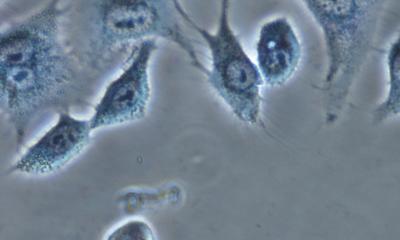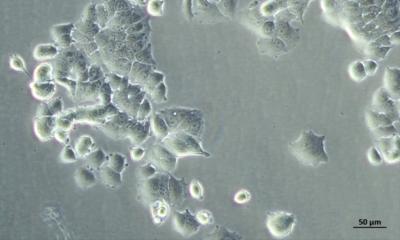
Image credit: Stupp Research Group/Northwestern University
News • Synthetic nanofibers
Repairing cartilage damage with ‘dancing’ molecules
Regenerative effects of molecules might be universal across tissue types
In November 2021, Northwestern University researchers introduced an injectable new therapy, which harnessed fast-moving “dancing molecules,” to repair tissues and reverse paralysis after severe spinal cord injuries.
Now, the same research group has applied the therapeutic strategy to damaged human cartilage cells. In the new study, the treatment activated the gene expression necessary to regenerate cartilage within just four hours. And, after only three days, the human cells produced protein components needed for cartilage regeneration.
The researchers also found that, as the molecular motion increased, the treatment’s effectiveness also increased. In other words, the molecules’ “dancing” motions were crucial for triggering the cartilage growth process.
The study was now published in the Journal of the American Chemical Society.
Current treatments aim to slow disease progression or postpone inevitable joint replacement. There are no regenerative options because humans do not have an inherent capacity to regenerate cartilage in adulthood
Samuel Stupp
“When we first observed therapeutic effects of dancing molecules, we did not see any reason why it should only apply to the spinal cord,” said Northwestern’s Samuel I. Stupp, who led the study. “Now, we observe the effects in two cell types that are completely disconnected from one another — cartilage cells in our joints and neurons in our brain and spinal cord. This makes me more confident that we might have discovered a universal phenomenon. It could apply to many other tissues.”
An expert in regenerative nanomedicine, Stupp is Board of Trustees Professor of Materials Science and Engineering, Chemistry, Medicine and Biomedical Engineering at Northwestern, where he is founding director of the Simpson Querrey Institute for BioNanotechnology and its affiliated center, the Center for Regenerative Nanomedicine. Stupp has appointments in the McCormick School of Engineering, Weinberg College of Arts and Sciences and Feinberg School of Medicine. Shelby Yuan, a graduate student in the Stupp laboratory, was primary author of the study.
As of 2019, nearly 530 million people around the globe were living with osteoarthritis, according to the World Health Organization. A degenerative disease in which tissues in joints break down over time, osteoarthritis is a common health problem and leading cause of disability.
In patients with severe osteoarthritis, cartilage can wear so thin that joints essentially transform into bone on bone — without a cushion between. Not only is this incredibly painful, patients’ joints also can no longer properly function. At that point, the only effective treatment is a joint replacement surgery, which is expensive and invasive. “Current treatments aim to slow disease progression or postpone inevitable joint replacement,” Stupp said. “There are no regenerative options because humans do not have an inherent capacity to regenerate cartilage in adulthood.”
Stupp and his team posited that “dancing molecules” might encourage the stubborn tissue to regenerate. Previously invented in Stupp’s laboratory, dancing molecules are assemblies that form synthetic nanofibers comprising tens to hundreds of thousands of molecules with potent signals for cells. By tuning their collective motions through their chemical structure, Stupp discovered the moving molecules could rapidly find and properly engage with cellular receptors, which also are in constant motion and extremely crowded on cell membranes.
Once inside the body, the nanofibers mimic the extracellular matrix of the surrounding tissue. By matching the matrix’s structure, mimicking the motion of biological molecules and incorporating bioactive signals for the receptors, the synthetic materials are able to communicate with cells. “Cellular receptors constantly move around,” Stupp said. “By making our molecules move, ‘dance’ or even leap temporarily out of these structures, known as supramolecular polymers, they are able to connect more effectively with receptors.”
In the new study, Stupp and his team looked to the receptors for a specific protein critical for cartilage formation and maintenance. To target this receptor, the team developed a new circular peptide that mimics the bioactive signal of the protein, which is called transforming growth factor beta-1 (TGFb-1).
Then, the researchers incorporated this peptide into two different molecules that interact to form supramolecular polymers in water, each with the same ability to mimic TGFb-1. The researchers designed one supramolecular polymer with a special structure that enabled its molecules to move more freely within the large assemblies. The other supramolecular polymer, however, restricted molecular movement. “We wanted to modify the structure in order to compare two systems that differ in the extent of their motion,” Stupp said. “The intensity of supramolecular motion in one is much greater than the motion in the other one.”
Although both polymers mimicked the signal to activate the TGFb-1 receptor, the polymer with rapidly moving molecules was much more effective. In some ways, they were even more effective than the protein that activates the TGFb-1 receptor in nature. “After three days, the human cells exposed to the long assemblies of more mobile molecules produced greater amounts of the protein components necessary for cartilage regeneration,” Stupp said. “For the production of one of the components in cartilage matrix, known as collagen II, the dancing molecules containing the cyclic peptide that activates the TGF-beta1 receptor were even more effective than the natural protein that has this function in biological systems.”
Stupp’s team is currently testing these systems in animal studies and adding additional signals to create highly bioactive therapies. “With the success of the study in human cartilage cells, we predict that cartilage regeneration will be greatly enhanced when used in highly translational pre-clinical models,” Stupp said. “It should develop into a novel bioactive material for regeneration of cartilage tissue in joints.” Stupp’s lab is also testing the ability of dancing molecules to regenerate bone — and already has promising early results, which likely will be published later this year. Simultaneously, he is testing the molecules in human organoids to accelerate the process of discovering and optimizing therapeutic materials.
Stupp’s team also continues to build its case to the Food and Drug Administration, aiming to gain approval for clinical trials to test the therapy for spinal cord repair. “We are beginning to see the tremendous breadth of conditions that this fundamental discovery on ‘dancing molecules’ could apply to,” Stupp said. “Controlling supramolecular motion through chemical design appears to be a powerful tool to increase efficacy for a range of regenerative therapies.”
Source: Northwestern University
30.07.2024











